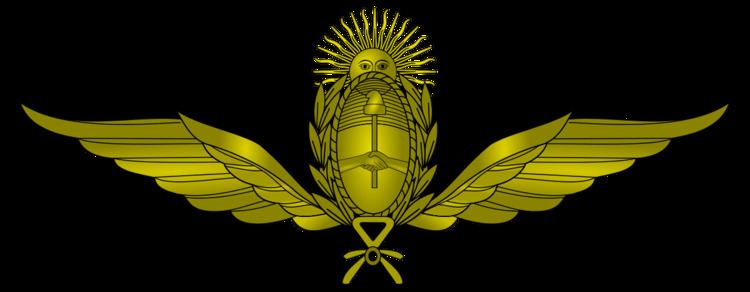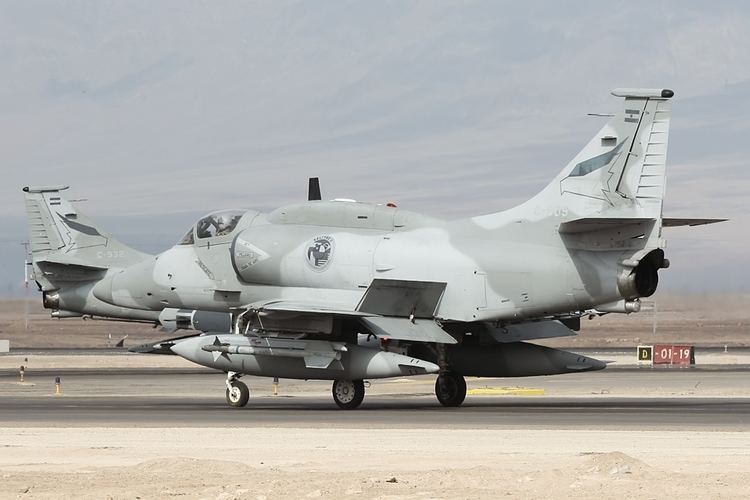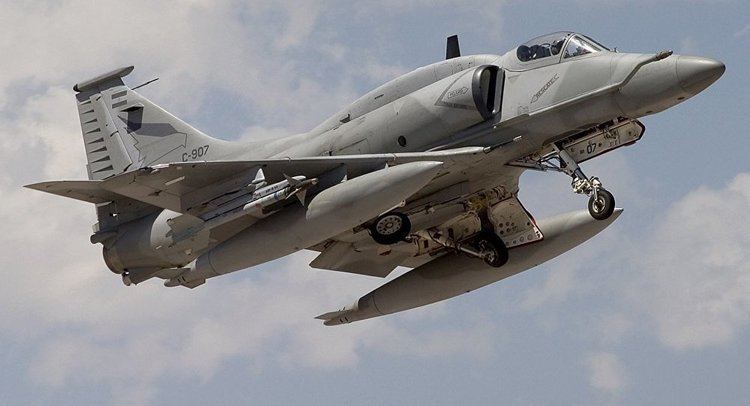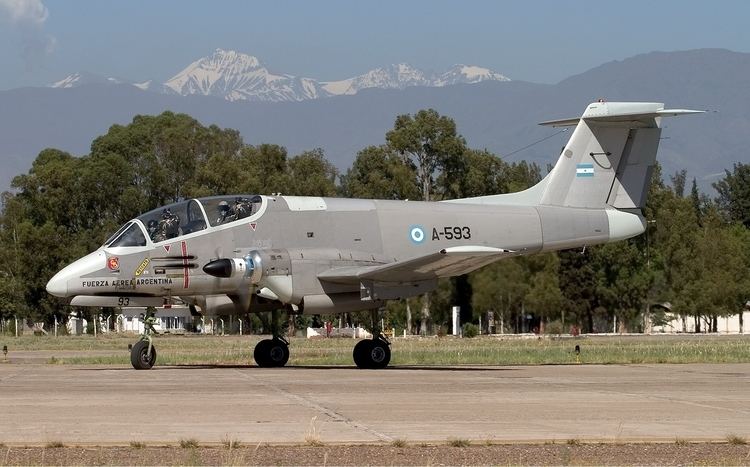Active 1945–Present Founded 1945 | ||
 | ||
Size 14,600 personnel163 aircraft March Alas Argentinas (Argentine Wings) Chief of Staff Lieutenant-General Enrique Víctor Amrein Transports Lockheed C-130 Hercules, Fokker F28 Fellowship, Fokker F27 Friendship, de Havilland Canada DHC-6 Twin Otter Similar Argentine Army, Argentine Navy, Armed Forces of the Argen, Chilean Air Force, Argentine Naval Aviation | ||
The Argentine Air Force (Spanish: Fuerza Aérea Argentina, or simply FAA) is the national aviation branch of the Armed Forces of the Argentine Republic. In 2010 it had 14,600 military personnel and 6,900 civilian personnel.
Contents
- Argentine air force in the malvinas war
- History
- Interwar period
- World War II and immediate post war
- Antarctic support
- Modernization and the Falklands War
- Support to UN peacekeeping missions
- In the 21st century
- 2010s
- Organization
- Order of battle
- Officers
- References

Argentine air force in the malvinas war
History

The Air Force's history begins with the establishment of the Army Aviation Service's Escuela de Aviación Militar (Military Aviation School) on 10 August 1912. Several military officers were amongst the pioneers of Argentine aviation, including Jorge Newbery, a retired Argentine Navy officer. The school began to turn out military pilots who participated in milestone events in Argentine aviation, such as the crossing of the Andes mountains.
Interwar period

In 1927 the Dirección General de Aeronáutica (General Directorate of Aeronautics) was created to coordinate the country's military aviation. In that same year the Fábrica Militar de Aviones (Military Aircraft Factory, FMA), which would become the heart of the country's aviation industry, was founded in Córdoba.

By 1938–39 Argentina's air power had about 3,200 staff (including about 200 officers), and maintained about 230 aircraft. About 150 of these were operated by the army and included Dewoitine D.21 and Curtiss P-36 Hawk fighters; Breguet 19 reconnaissance planes; Northrop A-17 and Martin B-10 bombers, North American NA-16 trainers, Focke-Wulf Fw 58 as multi-role planes, and Junkers Ju 52 and Fairchild 82 transports. About 80 were operated by the navy and included the Supermarine Southampton, Supermarine Walrus, Fairey Seal, Fairey III, Vought O2U Corsair, Consolidated P2Y, Curtiss T-32 Condor II, Douglas Dolphin and Grumman J2F Duck.
World War II and immediate post-war

By the 1940s there were several air units in the Army and the Navy; the first step towards an independent force came on 11 February 1944 with the establishment of the Aeronautical Command, which would go on to become the Argentine Air Force on 4 January 1945, an independent force on par with the Army and the Navy.

Immediately after the end of World War II, in which the Argentine Air Force took no part, it began a process of modernization, incorporating aircraft such as the Gloster Meteor jet fighter, thus becoming the first air force in Latin America equipped with jet-propelled aircraft. In addition, a number of Avro Lincoln and Avro Lancaster bombers were acquired, creating a powerful strategic force in the region. The Air Force, with former Luftwaffe officers as consultants and German technicians, also began to develop its own aircraft, such as the Pulqui I and Pulqui II, making Argentina the first country in Latin America and the sixth in the world to develop jet fighter technology on its own. Also locally developed aircraft, like the I.Ae. 22 DL trainer and the I.Ae. 24 Calquin tactical bomber, were added to the inventory.
Antarctic support
In 1952 the Air Force began flight to supply the Antarctic scientific bases using ski-equipped C-47s and establishing Marambio Base on 25 September 1969. On 11 April 1970 they began landing C-130 Hercules aircraft, when the TC-61 commanded by Commodore Arturo Athos Gandolfi was the first airplane to land in Marambio, and the Fokker F-28 Fellowship presidential aircraft T-01 Patagonia is reported to be the first jet to have landed at Marambio, on 28 July 1973. and since the 1970s Twin Otters are also deployed. On October 1973 the FAA launched Operation Transantar, achieving the first trans-Antarctic three-continental flight in history when a C-130 flew between Rio Gallegos; Marambio, Argentine Antarctica; Christchurch, New Zealand and Canberra, Australia.
Modernization and the Falklands War
In the 1960s new aircraft were incorporated, including the F-86 Sabre fighter and the Douglas A-4 Skyhawk ground-attack. During the 1970s the Air Force re-equipped itself with modern aircraft, including Mirage III interceptors, IAI Dagger multi-role fighters (Ex-Israeli, copy of the Mirage V), and C-130 Hercules cargo planes. A counter-insurgency airplane, the Pucará, was also used in substantial numbers.
The Falklands War (Spanish: Guerra de las Malvinas/Conflicto del Atlántico Sur), took a great toll on the Air Force, which lost 60 aircraft. After the war, due to the deteriorating economic situation, international opposition and political distrust of the military, the Air Force was denied the resources needed to replace the war losses. This, coupled with diminishing budgets, led to a period of reduced activity and growing materiel obsolescence.
After the war Britain imposed an arms embargo on Argentina, which was discontinued in the 1990s but British pressure has prevented so far the acquisition of modern fighter planes and equipment from Western countries. After attempts to acquire surplus IAI Kfirs or F-16As failed for economic and political reasons, the United States military sold Argentina 36 A-4AR Fightinghawks, a refurbished and upgraded version of the A-4 Skyhawks used in the war. Other equipment was bought: 23 US Army surplus OV-1 Mohawks, 22 Ex-Israeli IAI Dagger, 2 C-130B and 1 Lockheed L-100-30.
Support to UN peacekeeping missions
The FAA has been involved in United Nations peacekeeping missions around the world. They sent a Boeing 707 to the 1991 Gulf War. Since 1994 the UN Air contingent (UNFLIGHT) in Cyprus under UNFICYP mandate is provided by the FAA, having achieved 10,000 flight hours by 2003 without any accidents. The FAA has also since 2005 deployed Bell 212 helicopters to Haiti under MINUSTAH mandate.
In the 21st century
In early 2005 the top seventeen brigadiers of the Air Force, including the Chief of Staff, Brigadier General Carlos Rohde, were sacked by President Néstor Kirchner following a scandal involving drug trafficking through Ezeiza International Airport. Kirchner cited failures in the security systems of Argentine airports (which were overseen by the National Aeronautic Police, a branch of the Air Force) and cover-ups of the scandal; it later became known that many government agencies, among them the Interior Ministry, the Customs Administration and the Secretariat of State Intelligence knew about the drug trafficking.
The primary concerns of the Air Force as of 2010 are the establishment of a radar network for control of the country's airspace, the replacement of its older combat aircraft (Mirage III, Mirage V) and the incorporation of new technologies. The possibility of purchasing surplus French Air Force Mirage 2000C fighters, like the option chosen by the Brazilian Air Force, has been considered.
Since the 1990s the FAA has established good relations with its neighbours, the Brazilian and Chilean Air Forces. They annually meet, on a rotation basis, in the joint exercises Cruzex in Brazil, Ceibo in Argentina and Salitre in Chile.
In 2007 an FAA FMA IA 58 Pucará was converted to use a modified engine operating on soy-derived bio-jet fuel. The project, financed and directed by the Argentine Government (Secretaría de Ciencia Tecnología e Innovación Productiva de la Nación), made Argentina the second nation in the world to propel an aircraft with biojet fuel. The purpose of the project is to make the FAA less reliant on fossil fuels.
2010s
As of 2010 budgetary constraints continued, leading to the disbanding of the Boeing 707 transport squadron and maintenance problems for half of the C-130 Hercules fleet. This was particularly evident when, in a matter of days in March, the same C-130 aircraft could be seen, in addition to their routine missions, travelling 3 times to Haiti, 9 times to Chile (in both cases delivering humanitarian aid) and also doing a resupply airdrop to the Argentine southernmost Antarctic base Belgrano II.
In August 2010 a contract was signed for two Mi-17E helicopters, plus an option on a further three, to support Antarctic bases although no official destination for them have been released yet and is possible that they will be assigned to the Argentine Army Aviation.
The FAA is seeking to replace its ageing force with a more capable and more serviceable modern aircraft. The acquisition of Spanish Mirage F1Ms, IAI Kfir Block 60s and Saab Gripen E/Fs was considered, but as of February 2015, all of those deals appear to have stalled; The Mirage F1 deal was scrapped by the Spanish government in March 2014 after pressure of the UK to not assist in FAA modernization over tensions between the countries over the Falkland Islands. The UK has also managed to veto the sale of Gripen E/Fs, as 30% of the Gripen's parts are manufactured there. The deal with Israel has reportedly stalled for technical and political reasons. China has reportedly offered JF-17/FC-1 or Chengdu J-10 to Argentina. The two countries have formed a working group to look into the transfer of 14 aircraft. Russia had also offered to lease 12 Su-24 strike aircraft to the FAA, but Jane's reported that the Su-24 wouldn't be very useful to the FAA and that "it would appear that any proposed transfer of such aircraft is likely the result of Russia playing political games with the UK over the continuing crisis in Ukraine.". All Mirages were officially decommissioned on 30 November 2015. The A-4's were grounded as of January 2016 for lack of spares; in any case only 4-5 were airworthy with the rest in storage at Villa Reynolds. When Barack Obama visited in March 2016, Air Force One was accompanied by US Air Force F-16's because Argentina could only offer Pucarás and Pampas for air defense.
According to Sputnik news on January 27, 2017, Argentina has sent a commercial offer to Russia to purchase up to or more than 15 Mig-29 Multirole Fighters. This was done to begin efforts to modernize its airforce and restore a true air defense capability. Deputy Director of the Russian Federal Service for Military-Technical Cooperation (FSMTC) Anatoly Punchuk, has stated that Russia is preparing a response to the FAA.
According to news from Asian Defense, another purchase in the works for the FAA. A deal was created with China for a supply of 20 FC-1 fighters. It would give the FAA a new potent strike capability. It would enable the FAA to strike at the disputed Falklands Islands, which were liberated by Great Britain in 1982. Previous negotiations with Russia on the sale of 24 SU-24 Fencer Fighter Bombers had failed, thus forcing Buenos Aires to turn to China. The deal with China also includes 15 economic agreements, and financial investments to bolster Argentina's troubled economy.
Organization
The Argentine Air Force is one of the three branches of the Argentine military, having equal status with the Army and the Navy. The President of Argentina is Commander-in-Chief of all three services.
The Air Force is headed by the Chief of the General Staff (Jefe del Estado Mayor General), directly appointed and removed by the President. The Air Force Chief of Staff usually holds the rank of Brigadier General, the highest rank of the Air Force. The Chief of Staff is seconded by a Deputy Chief of the General Staff and three senior officers in charge of the Air Force's three Commands: the Air Operations Command, the Personnel Command and the Materiel Command.
The Air Operations Command (Comando de Operaciones Aéreas) is the branch of the Air Force responsible for aerospace defense, air operations, planning, training, technical and logistical support of the air units. Subordinate to the Air Operations Command are the Air Brigades (Brigadas Aéreas), the Air Force's major operative units. A total of eight Air Brigades are currently operational. Brigades are headquartered at Military Air Bases (Base Aérea Militar (BAMs).
Each Air Brigade is made up of three Groups, each bearing the same number as their mother Brigade. These groups include:
The Personnel Command (Comando de Personal) is responsible for the training, education, assignment and welfare of Air Force personnel. Under the control of the Personnel Command are the Military Aviation School (which educates the future officers of the Air Force), the Air Force Non-Commissioned Officer (NCO) School and other educational and training units.
The Materiel Command (Comando de Material) deals with planning and executing the Air Force's logistics regarding flying and ground materiel. Materiel Command includes "Quilmes" and "Río Cuarto" Materiel Areas (repairing and maintenance units) and "El Palomar" Logistical Area.
Order of battle
Officers
Officers wear their rank insignia in their sleeves, in the pattern depicted below. There are also shoulderboards with the same insignia (albeit in gray) for the ranks between Ensign and Commodore. General officers wear different shoulder boards.
